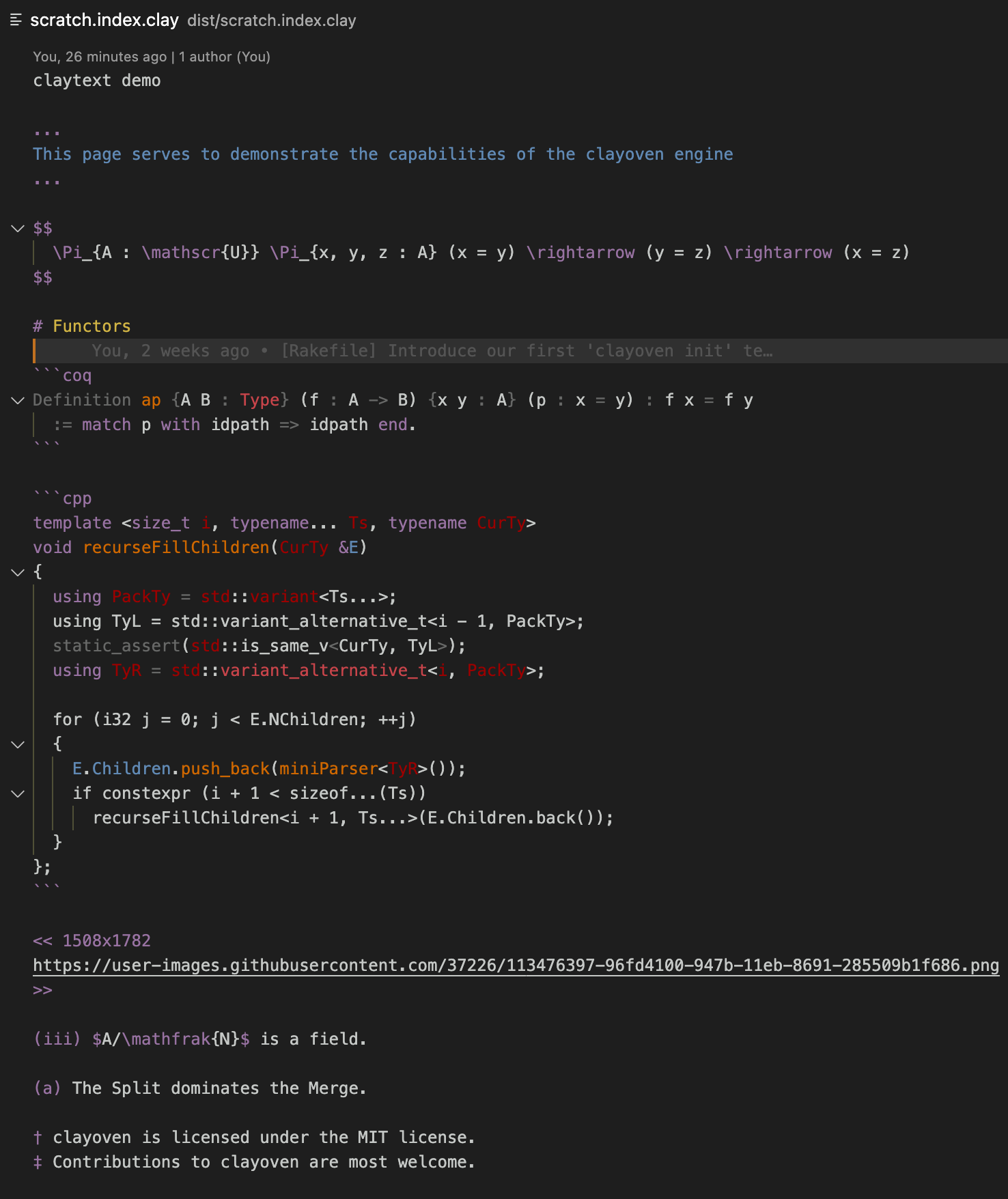clayoven is a beautiful static site generator with a carefully curated set of features. It has been built at a glacial pace, over a period of nine years, as my website expanded in content. I have a spread of mathematical notes, both typeset and handwritten, software-related posts, and some wider-audience articles; while clayoven is primarily aimed at math-heavy sites, it is good on all three fronts. The source files are written in "claytext", a custom format built for elegance and speed.
rdoc documentation is available here.
- Small! ~700 lines of well-written and well-documented Ruby.
- Beautiful and easily extensible markup, with a dedicated vscode plugin for it.
- Automatically picks timestamps from git history, respecting moves.
- Server-side rendering of math, including commutative diagrams, via MathJaX and XyJaX.
A starter project is bundled with the following scratch.index.clay:
whose rendered output can be seen here.
Here's an excerpt of embedded MathJaX with IntelliSense powered by vsclay:
There is no published gem. To get started, clone, run bundle to install the required gems, and put bin/clayoven in $PATH. Then, run clayoven init in a fresh directory. To start writing, install vsclay for vscode, which will provide the necessary syntax highlighting, IntelliSense support for MathJaX, and trigger-[incremental build]-on-save functionality.
All site content is split up into "topics", to put in the sidebar, each of which can either serve as an index to a collection of ContentPages (as a bunch of .clay files in a subdirectory with the name #{topic}), or a single IndexPage (named #{topic}.index.clay). index.clay is special-cased to serve as the root of the site.
So, if you have these files,
.vscode/ # provided by `init`
.htaccess # provided by `init`
lib/ # provided by `init`
design/ # provided by `init`
index.clay # provided by `init`
scratch.index.clay # provided by `init`
404.index.clay # provided by `init`
blog.index.clay
blog/personal/1.clay
blog/math/1.clay
colophon.index.clay
clayoven automatically builds a sidebar with index, blog and colophon (each of which are instances of IndexPage). /blog will have links to the posts /blog/personal/1 and /blog/math/1 (each of which are instances of ContentPage), under the titles personal and math (the "subtopics"). If there are multiple ContentPage entries under an IndexPage, the latter simply serves to give a introduction, with links to articles automatically appearing after the introduction. IndexPage and ContentPage are run through the same design/template.slim, and the template file has access to the accessors.
The engine works closely with the git object store, and builds are incremental by default; it mostly Just Works, and when it doesn't, there's an option to force a full rebuild. The engine also pulls out the created-timestamp (Page#crdate) and last-modified-timestamp (Page#lastmod) from git, respecting moves. ContentPages are sorted by crdate, reverse-chronologically, and IndexPages are sorted alphabetically.
clayoven initto generate the necessary starter project.clayovento generate HTML files incrementally based on the current git index.clayoven aggressiveto regenerate the entire site; only requires to be run on occassion.clayoven httpdto preview your website locally.
.clayoven/sitenameis URL of the site, excluding thehttps://prefix..clayoven/hiddenis a list ofIndexFilesthat should be built, but not displayed in the sidebar. You would want to use it for your 404 page and drafts..clayoven/tzis a timezone-to-location mapper, with lines of the form+0000 London. clayoven digs through the git history for locations, and exposes aPage#locations..clayoven/subtopicis a [subtopic directory]-to-subtitle mapper, with lines of the forminf ∞-categories.
The claytext processor is, at its core, a paragraph-processor; all content must be split up into either plain paragraphs, or "fences" (multiple paragraphs delimited by start and end tokens). The function of most markers should be evident from the scratch.html produced by a clayoven init. The format is strict, and the processor doesn't like files with paragraphs wrapped using hard line breaks.
Clayoven::Claytext::Transforms::LINE matches paragraphs where all lines begin with some regex, and Clayoven::Claytext::Transforms::Fenced match fences (could be multiple paragraphs) that start and end with the specified tokens. In addition to this, there are inline markdown markers `...` and [...](...), for content that is to be put in <mark> and <a>, respectively.
- Check in the generated HTML to the site's repository, so that eyeballing
git diffcan serve as a testing mechanism. - If you accidentally commit
.clayfiles before running clayoven, running it afterward will do nothing, since it will see a clean git index; you'll need to run the aggressive variant. - Importing historical content is easy; a
git commit --date="#{historical_date}"would give the post an appropriate creation date that will be respected in the sorting-order.
- Have one unified dhall configuration.
- Allow the user to extend claytext syntax with configuration.
- Hit 100% test coverage.
- Get vsclay to report syntax errors.
- Anti: extend clayoven in ways that would necessitate an ugly implementation.



